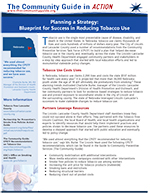Blueprint for Success in Reducing Tobacco Use
Summary
 The City of Lincoln and Lancaster County, Nebraska used Community Guide recommendations to build a plan to lessen tobacco use. Their approach led to county-wide reductions in tobacco use, and led to the state’s decision to model their smoking ban on the one developed by the City of Lincoln, and eventually, to monumental state-wide policy changes. (Released 2012)
The City of Lincoln and Lancaster County, Nebraska used Community Guide recommendations to build a plan to lessen tobacco use. Their approach led to county-wide reductions in tobacco use, and led to the state’s decision to model their smoking ban on the one developed by the City of Lincoln, and eventually, to monumental state-wide policy changes. (Released 2012)Lessons Learned
- Demonstrate why change is important. The Lincoln team gained support for their efforts by using the Task Force’s evidence-based findings to show their partners interventions and policy changes found to be effective, and explaining how they could improve health outcomes in their community.
- Educate stakeholders. Keeping the media, policymakers, and other community influencers informed about the health problem and what works to address it will help get the message heard and ensure that the message is transmitted as accurately as possible.
- Take it one step at a time. The Lincoln team found that grassroots success can lead to bigger rewards. Building support from the ground up can help secure policy changes that reinforce healthy behaviors in the community.
Story
Tobacco Use Costs Lives
In Nebraska, tobacco use claims 2,200 lives and costs the state $537 million for health care every year.1 It is projected that more than 36,000 Nebraska youth under the age of 18 will ultimately die prematurely from smoking.2 These alarming trends motivated Charlotte Burke, manager of the Lincoln Lancaster County Health Department’s Division of Health Promotion and Outreach, and her community partners to look for evidence based strategies to reduce tobacco use and prevent exposure to secondhand smoke in the city of Lincoln and the surrounding county. The state of Nebraska leveraged Lincoln Lancaster’s successes to make statewide changes to reduce tobacco use.
Partners Leverage Resources
The Lincoln Lancaster County Health Department staff members knew they could not succeed alone in their efforts. They partnered with the Tobacco Free Lincoln Coalition, the local Board of Health, and local health organizations and experts to identify resources that would help them implement practices and policies shown to decrease tobacco use. The partners used these resources to develop a stepped approach that started with public education and eventually led to policy change.
“We used almost everything that the Task Force recommended for reducing tobacco use,” says Ms. Burke. The Lincoln team used the following Task Force recommendations, which can be found in the Guide to Community Preventive Services (Community Guide):
- Community mobilization with additional interventions,
- Mass media education campaigns combined with other interventions,
- Smoke-free policies to reduce tobacco use among workers,
- Increasing the unit price for tobacco products (statewide), and
- Smoking bans and restrictions [PDF – 227 kB]
Building the Foundation
The team’s first step was to mobilize and educate their community. They began by building relationships with key individuals and community groups, and using the Community Guide to educate them on interventions and policy changes shown to work. “I often use the Community Guide to show evidence-based interventions to community groups,” explains Ms. Burke. “It helps build their trust and gain traction and support for our efforts.”
Based on the Task Force recommendations, the Lincoln team knew it would be vital to earn the media’s support. As Ms. Burke tells it, “Editors were much more inclined to publish our information after we talked with them in person.” This strategy resulted in well-written, fact-based articles illustrating the harmful effects of tobacco and the interventions that work to curb its use.
Education Leads to Policy Change
“When we felt we had done enough education in the community, we began encouraging policy changes,” explains Ms. Burke. “Our Board of Health requested an ordinance from the city council to prohibit smoking in indoor public and work areas.” The team’s efforts to engage local leadership and the public helped secure passage of the Lincoln Smoking Regulation Act with 62 percent of the vote. This was the first successful indoor smoking ban statewide. Within a few years of the ban, county smoking rates decreased from 19.3 percent to 15.5 percent among adults, and from 23.5 percent to 16.4 percent among youth. In addition, more than 100 housing complexes and 40 percent of hotels had gone smoke-free.
With local successes under their belt, the Lincoln team joined statewide efforts to decrease tobacco use by educating the public and policymakers about the value of raising the tobacco tax. The state team’s first win came when Nebraska instituted a 30 cent tax hike on tobacco products. The next win came when the state, spurred by Lincoln Lancaster’s success, revised its Clean Indoor Air Act to model the Lincoln city smoking ban. On June 1, 2009, Nebraska became a 100 percent smoke-free state. All indoor work spaces and public places across the state are now required by law (supported by 80 percent of Nebraskans, smokers, and non-smokers alike) to be smoke-free. On the eve of the ban, Nebraska’s Chief Medical Officer shared, “This law is great for the public health of all Nebraskans. [We] will enter a new era of better health and wellness.” Three months after the ban, 86 percent of Nebraskans agreed that restaurants and bars were healthier thanks to the new state law.3
This finding was updated and replaced by the 2012 Task Force finding for Tobacco Use and Secondhand Smoke Exposure: Smoke-Free Policies.
1 Tobacco Free Lancaster County, Highlights 2009-2010. tobaccofreelancastercounty.org/wp-content/uploads/2014/08/highlight-09-10-I.pdf [PDF – 60 kB].
2 Reducing Tobacco Use in Nebraska: A Snapshot Progress Report. dhhs.ne.gov/Documents/09TFN_Snapshot.pdf [PDF – 193 kB].
3 Tobacco Free Nebraska: Data and Trends on Tobacco Use in Nebraska www.tobaccofreelancastercounty.org/wp-content/uploads/2010/06/Smoke-Free-Housing-Trends.pdf [PDF – 232 kB].